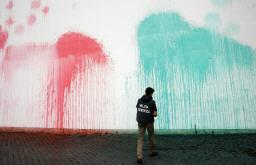A wall of Rome's controversial Ara Pacis museum was spattered in bursts of red and green paint on Monday in an attack by unidentified vandals.
Police arrived on the scene at dawn after being alerted to the paint splashes, which were in the colours of the Italian flag.
Designed by American architect Richard Meier and opened in 2006, the sleek stone-and-glass complex that houses Emperor Augustus's altar of peace is central Rome's first piece of modern architecture since Fascist days.
It has long come under fire from critics including Rome Mayor Gianni Alemanno, who has distanced himself from an old election promise to tear the building down but has begun talks with Meier to ''rethink'' its design.
Alemanno was nevertheless quick to condemn Monday's attack ''in the strongest terms''.
''Hooliganism and acts of vandalism will not influence the debate on architectural works in the city,'' he said.
''This has happened right at the time that the (city council) is speaking to Richard Meier to find an architectural solution that could improve the urban impact of the museum. I hope that the investigators find who is responsible and make them pay for this idiotic and irresponsible act''.
Rome's culture superintendent, Umberto Broccoli, also hit out at the unknown vandals.
''This is a serious, useless, and damaging act against the monument which hosts important initiatives and which, polemics aside, has become a reference point for culture in the city.''
Broccoli also pointed out that after a recent trip to Israel Alemanno announced plans to make the Ara Pacis a centre of peace ''in line with the ancient meaning of the monument''.
SUSPICION FALLS ON RED TREVI MAN.
Following Monday's colourful attack, suspicion immediately fell on Graziano Cecchini, the self-styled 'Futur-rista' who made world headlines after tipping non-permanent red dye into the Trevi Fountain in 2007 and sending about half a million coloured balls thundering down Rome's Spanish Steps in 2008.
But former right-wing extremist Cecchini, who said he had been questioned by police over the incident, was ambiguous about his involvement.
''Intellectually I claim responsibility for this beautiful action - there should be one a day,'' he said.
''There are closed-circuit cameras that should show with certainty who it was. If they don't work someone needs to complain about the squandering of public money,'' he added.
Cecchini nevertheless seemed to have an idea of how the attack was carried out, explaining that the paint splashes would have been accomplished using paint-filled balloons and ''a toilet positioned at the bottom of the wall that has now been confiscated''.
''I think that it represents an Italy that splits upwards (with the balloons) and downwards (with the toilet). Maybe it's sign that people are fed up of an Italy of showgirls,'' said Cecchini, who received an eight-month suspended sentence for the Spanish Steps balls incident.
Cecchini's prank was a protest against the ''balle'' (balls, or lies) allegedly fed to a gullible public by politicians of all stripes.
He threw dye into the basin of the Trevi Fountain a few months earlier during the Rome Film Festival, delighting tourists and enraging officials, in an act apparently inspired by the Futurists of the early 20th century.
''There's the red carpet, Valentino red and now red Trevi too,'' he said, adding that he was trying to raise awareness of the plight of Italy's casual workers.
The dye assault was claimed by 'FTM Futurist Action 2007', a previously unknown group which said it aimed to turn this ''grey bourgeois society into a triumph of colour''.
Cecchini won several plaudits after his Trevi feat, including from Milan's then culture chief, prominent art critic Vittorio Sgarbi.
Sgarbi also liked the Spanish Steps balls, saying ''anarchy is a typical feature of contemporary art''.
Cecchini has yet to be charged for the Trevi incident, for which he could face a heavier penalty.
The Ara Pacis was commissioned in 13 BCE to celebrate peace throughout the Roman Empire.
It was completed in 9 BC, 23 years before Augustus's death at the age of 76 in 14 AD.
It shows the architectural hub of Ancient Rome, circled by a bas relief of a procession of peace showing Aeneas, the Earth, Italy and Rome, and marked the first emperor's victorious return from Spain and Gaul and celebrated the peace he had restored to the empire.







